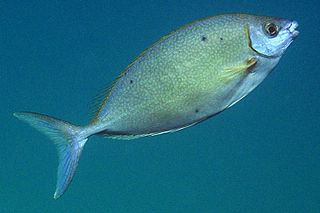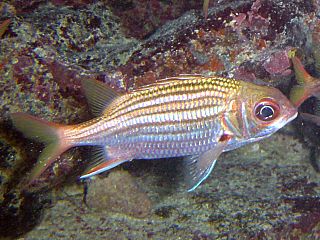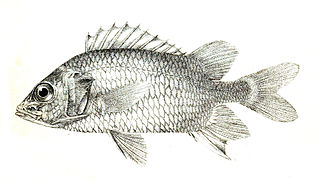
Sargocentron is a genus of squirrelfish found in tropical parts of the Indian, Pacific and Atlantic Oceans, with the greatest species diversity near reefs in the Indo-Pacific. Being largely or entirely nocturnal, they have relatively large eyes. Red and silvery colours dominate. The preopercle spines are venomous and can give painful wounds. Most have a maximum length of 15–25 cm (6–10 in), but S. iota barely reaches 8 cm (3 in), and S. spiniferum can reach more than 50 cm (20 in).

Monodactylus argenteus is a species of fish in the family Monodactylidae, the moonyfishes. Its common names include silver moonyfish, or silver moony, butter bream, and diamondfish. It is native to the western Pacific and Indian Oceans, including the Persian Gulf, Red Sea, and associated estuaries, such as the Mekong Delta.

The longspine squirrelfish is a silvery red, sea fish with orange-gold body stripes. One of about 150 species of squirrelfish, their most distinguishing characteristics are their large eyes and the long third spine of the anal fin. It is often included in public aquarium displays. The length of the longspine squirrelfish is about 18 cm. It lives in coral reefs in tropical and warm temperate seas and eats zoobenthos. It is territorial and uses sounds called "grunts" and "staccatos" to defend its crevice, warn of danger and, in groups, intimidate predators such as the moray eel. The longspine squirrelfish is edible and harvested on a small scale.

The streamlined spinefoot, also known as the forktail rabbitfish, schooling rabbitfish or silver spinefoot, is a species of marine ray-finned fish, a rabbitfish belonging to the family Siganidae. It is found in the Indo-Pacific region.

Neoniphon is a genus of squirrelfishes.

Sargocentron spiniferum, common name sabre squirrelfish, giant squirrelfish and spiny squirrelfish, is a large Indo-Pacific species of squirrelfish belonging to the family Holocentridae.

Holocentrus adscensionis is a squirrelfish of the family Holocentridae found in the Atlantic Ocean. Its range extends from North Carolina, USA to Brazil and throughout the Caribbean Sea in the Western Atlantic and from Gabon to Ascension Island in the Eastern Atlantic. A single records were reported in 2016 from the central Mediterranean Sea off Malta and in 2023 from the Mediterranean Sea near Northern Cyprus.

Myripristis botche, the blacktip soldierfish, splendid soldierfish, or splendid squirrelfish, is a species of soldierfish belonging to the family Holocentridae.

The redstripe pipefish is a fish from the genus Dunckerocampus.

Neoniphon opercularis, the blackfin squirrelfish, also known as the mouth-fin squirrelfish or clearfin squirrelfish, is a species of squirrelfish found in the Indian Ocean and Pacific Ocean from East Africa as far east as New Caledonia. It lives alone or in small groups in or near reefs and lagoons between 3 and 25 metres deep and can reach sizes of up to 35.0 centimetres (13.8 in) TL. It eats crabs and shrimps. Its dorsal fin is raised to scare off or startle predators. It also has a large venomous spine at the corner of its preopercle. It is relatively unaffected by commercial fishing, but is sometimes used as bait for tuna fisheries.

Neoniphon sammara, the sammara squirrelfish, also known as the blood-spot squirrelfish, slender squirrelfish, spotfin squirrelfish, armed squirrel-fish or javelin squirrelfish, is a species squirrelfish found in the Indian Ocean and Pacific Ocean from East Africa to the Hawaiian Islands. It feeds on shrimps and small crabs and fish at night and can grow up to 32.0 centimetres (12.6 in) TL in length, though its common length is only 23.0 centimetres (9.1 in) TL. Like N. opercularis, it has a venomous spine on its preopercle.

Neoniphon marianus, also known as the longjaw squirrelfish, is a species of squirrelfish found in the Western Atlantic Ocean from the Florida Keys south to Trinidad and throughout the Caribbean Sea. It lives near reefs at depths between 1 and 70 metres, usually between 30 and 60 metres, and can reach sizes of up to 18.0 centimetres (7.1 in) TL. It is nocturnal and consumes mostly shrimps, but will also eat crabs.

Sargocentron caudimaculatum, the silverspot squirrelfish or whitetail squirrelfish, is a reef-associated member of the family Holocentridae. It is native to the Indian and Pacific Oceans from East Africa to Japan and northern Australia and as far east as the Marshall Islands. It lives near reefs, but can also be found in lagoons and drop-offs at depths between 2 and 40 metres. It is a nocturnal predator, feeding primarily on crabs and shrimps. It can reach sizes of up to 25.0 centimetres (9.8 in) TL. Although it is caught commercially and can be found in the aquarium trade, there are no known major threats to this species.

Sargocentron dorsomaculatum, also known as the spotfin squirrelfish, is a species of squirrelfish found in the western Pacific Ocean near the Ryukyu Islands, Pohnpei, Kosrae, the Caroline Islands, and Palau. It lives in shallow reefs at depths between 2 and 9 metres. Like other members of its genus, it is nocturnal and seeks shelter among corals and other structures. It can reach sizes of up to 19.7 centimetres (7.8 in) SL.

Sargocentron ensifer, or the yellow-striped squirrelfish, is a member of the family Holocentridae. It is native to the Pacific Ocean from southern Japan to New Caledonia, Hawaii and the Pitcairn Islands. It lives in deep reefs at depths between 0 and 64 metres, hiding in crevices by day and foraging for food by night. It feeds on small fishes and crustaceans and can reach sizes of up to 23.0 centimetres (9.1 in) SL, though a length of 15.0 centimetres (5.9 in) TL is more common.

Sargocentron microstoma, the fine-lined squirrelfish, slender squirrelfish or smallmouth squirrelfish, is a member of the family Holocentridae. It has a wide range throughout the Indo-Pacific from the Chagos Archipelago, Seychelles, and the Maldives to the Hawaiian Islands, Line Islands, and the Tuamotus Archipelago, north to the Ryukyu Islands and Bonin Islands, south to Austral Islands and throughout Micronesia. It lives near reefs usually at depths between 1–35 m (3.3–114.8 ft), but can be found as deep as 183 m (600 ft). During the day it hides in crevices, especially near Acropora and Pocillopora. It is a nocturnal predator, feeding on crustaceans, worms, and fishes. It can reach sizes of up to 20 cm (7.9 in) TL and has a venomous preopercle.

Neoniphon aurolineatus, more commonly known as the yellowstriped squirrelfish or gold-lined squirrelfish, is a member of the family Holocentridae. It has a wide range throughout the Indian and Pacific Oceans stretching east from Mauritius to Hawaii and south from Japan to the Great Barrier Reef of Australia. It lives on the outer reef slopes at depths between 30 and 188 metres. It lives near the ocean floor or in caves, generally staying alone or in small groups. It feeds on crustaceans and can reach sizes of up to 25.0 centimetres (9.8 in) TL. It is listed as "Least Concern" by the IUCN due to its deep-water habitat and lack of known major threats.

Pomadasys argenteus, the silver grunt, silver javelin, grunter bream, small-spotted grunter-bream, small-spotted javelin fish, trumpeter or white-finned javelin fish, is a species of marine ray-finned fish, a grunt from the family Haemulidae. This species has a wide Indo-Pacific distribution. It is the type species of the genus Pomadasys.
Neoniphon pencei, or Pence's squirrelfish, is a species of squirrelfish found in the Pacific Ocean in Rarotonga, Cook Islands and Mo'orea, French Polynesia. It differs from other species of the genus Neoniphon in number of lateral line scales, scales above and below lateral line, elements of life colour, and in COI and cytochrome b DNA sequences.
Sargocentron poco, the saddle squirrelfish, is a species of squirrelfish belonging to the genus of Sargocentron. It is found in the Western Central Atlantic Ocean from the United States to the Cayman Islands, and in the Bahamas. It may also possibly be found in Cuba. It is likely to be more commonly found inhabiting shelf-edge reefs.



















